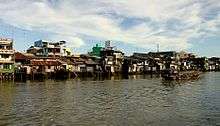Bảo Định Canal

Waterfront houses in Mỹ Tho
The Bảo Định canal (kênh Bảo Định, Bảo Định Hà) also called the Bảo Định river (Bảo Định Giang, sông Bảo Định) is a part-natural, part-man made waterway in the Mekong Delta in Vietnam. It is in places also named the Vũng Gù canal (kênh Vũng Gù, (sông Vũng Gù).
The canal runs from the Vàm Cỏ Tay river at Tân An to the Tiền River at Mỹ Tho.[1]
History
The waterway first began to be manually improved in the rulership of Nguyễn Phúc Chu (1675–1725).[2] The canal was substantially deepened and extended in the reign of Gia Long,[3] with 9,000 workers being mobilised to connect the two rivers around 1819.[4]
References
- ↑ Rough Guide to Vietnam Jan Dodd, Mark Lewis, Ron Emmons - 2003 - Page 140 "My Tho.. Also visible from here is the clot of cheery blue fishing vessels that moor at the mouth of the Bao Dinh Canal, while cargos ... As well as the usual piles of fruit, cereals and tobacco, several stalls sell ships' chandlery, their heaped fishing nets ..."
- ↑ Nadine Reis Tracing and Making the State: Policy Practices and Domestic Water ... 2012 Page 34 "While the natural floodways in the eastern part of the delta already began to change in 1705 with the construction of the Bao Dinh Canal between the Tien River at My Tho (Tien Giang province) and the Vam Co Tay River at Tan An (Long An province), the middle and western parts of the delta remained largely free from human impact ..."
- ↑ Nghiên cứu lịch sử Viện sử học (Vietnam) - 2007 - Numéros 375 à 380 - Page 65 "Kênh Bảo Định đào xong đã tạo nên một .."
- ↑ Guerre et paix en Asie du Sud-Est - Page 270 Thê ́Anh Nguyêñ, Alain Forest - 1998 "Le creusement du Bao Dinh Giang en 1819 mobilisa 9 000 hommes et relia le Waïco occidental au Tiên Giang."
This article is issued from
Wikipedia.
The text is licensed under Creative Commons - Attribution - Sharealike.
Additional terms may apply for the media files.


